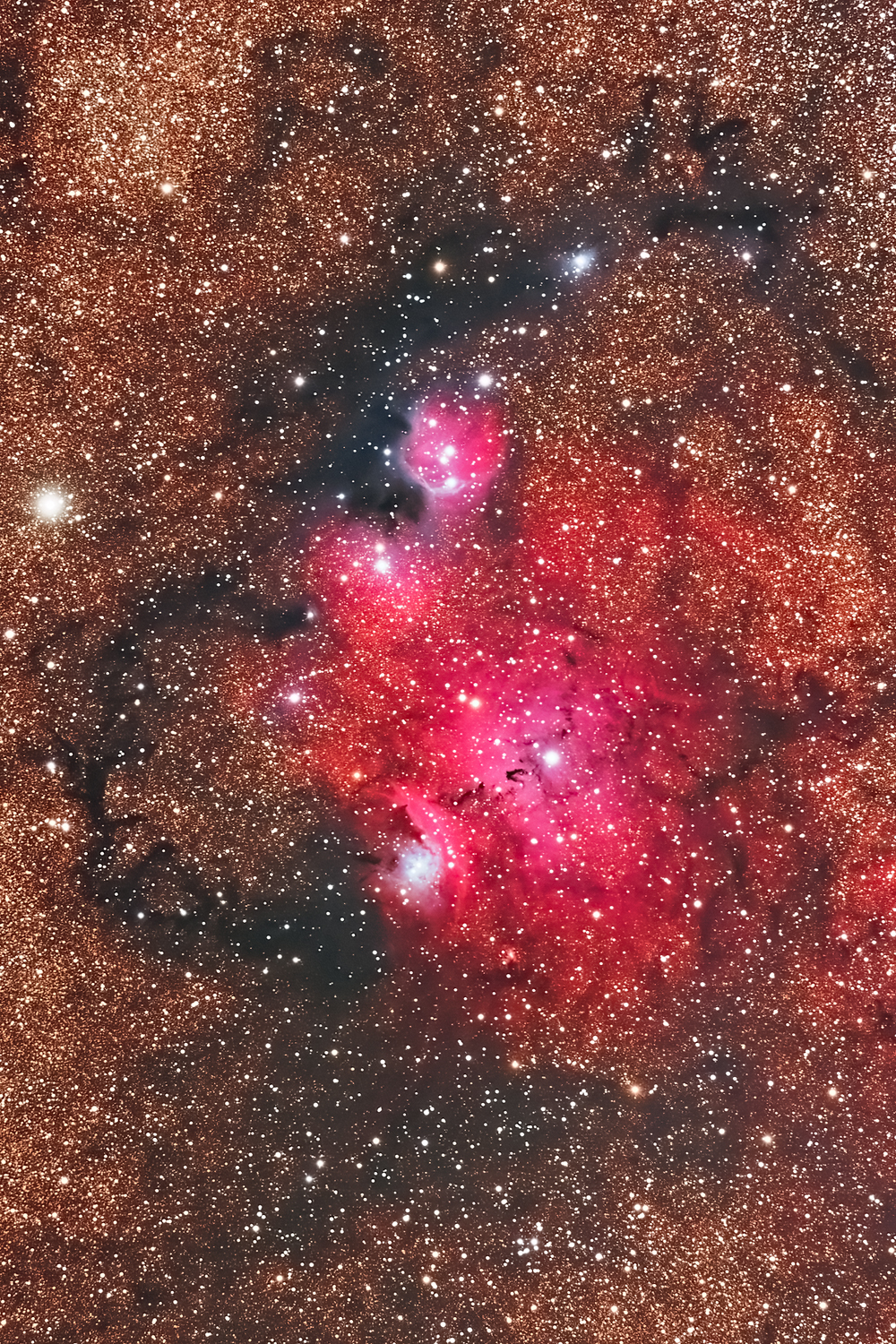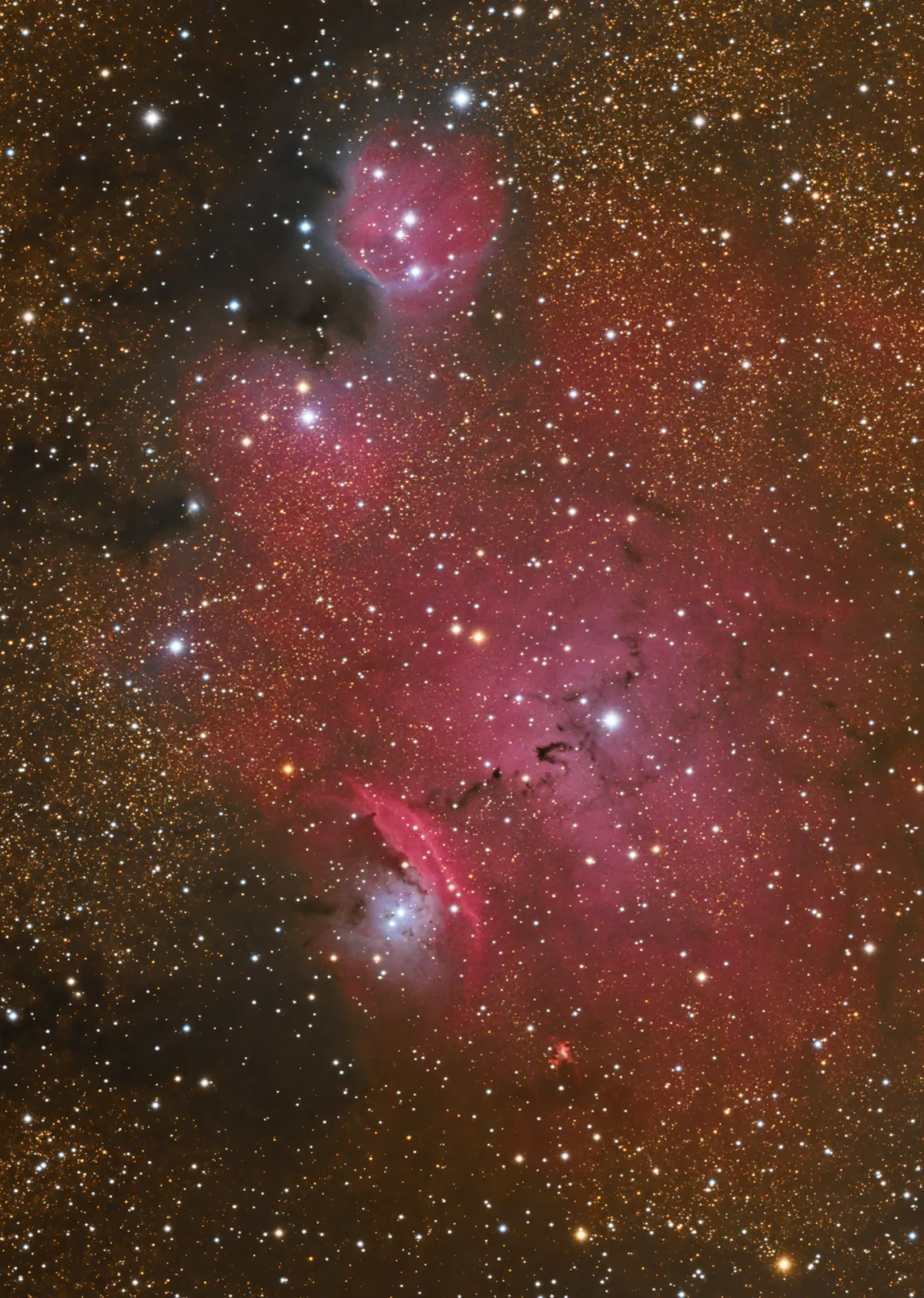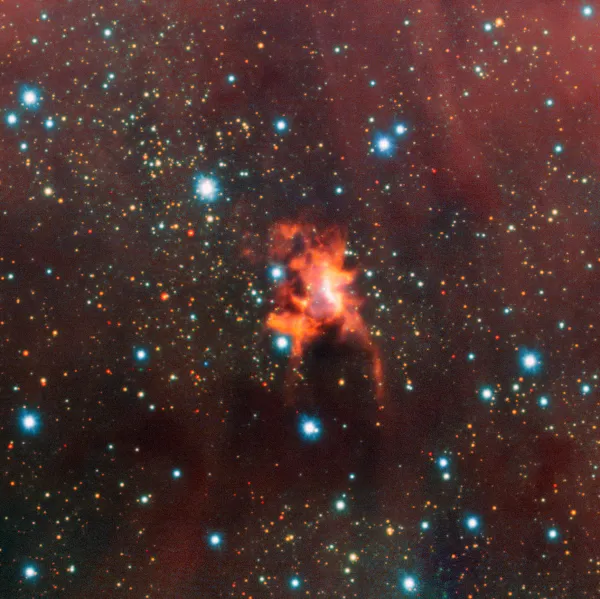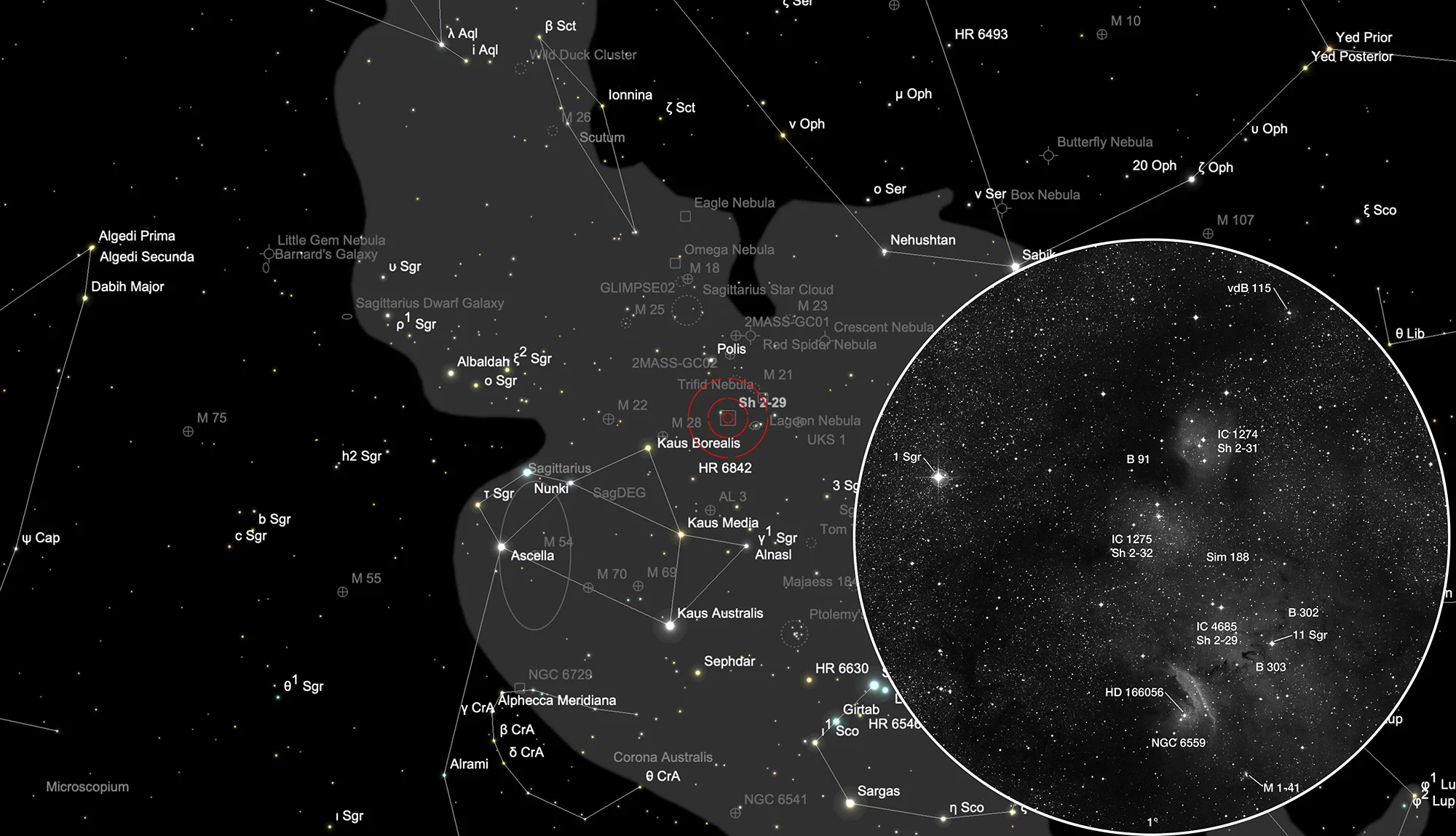Psychedelic Nebula (Simeis 188) & Minkowski 1-41


History
The brightest part of this nebula was first sighted by John Herschel on 1st July 1826 using his reflecting telescope with 18.3 inch aperture and 20 feet focal length. In his «Slough Catalogue» of 1833 he listed it as h 1996 and noted: «Several stars affected with nebulosity: The brightest taken.» [466] On 27 June 1837 observing from South Africa he listed the same nebula as h 3733 and noted: «Very faint, large, oblong, 5' long, 3' broad, place of a double star involved; 6 other stars nearby. Query if involved.» [11] In his «General catalogue» of 1864 he listed the nebula as GC 4384 and wrote: «very faint, very large, little extended, double star involved.» [467] In 1888 John L. E. Dreyer then added the nebula as NGC 6559 to his well known «New General Catalogue». [313]
On 25 June 1892 Edward Emerson Barnard took a photograph of that region and discovered two more nebulae which were added as IC 1274 and IC 1275 by John L. E. Dreyer in 1895 to his first «Index Catalogue». [314] On 27 June 1895 Barnard took again a photograph and identified two more nebulae: IC 4684 and IC 4685. In 1905 he also found IC 4681. [315] Later Barnard identified also several dark nebulae. [239, 609]
In 1952 the Russian astronomers Grigory Abramovich Shajn and Vera Fedorovna Gaze worked at the Simeiz Observatory in Crimea. They were probably the first ones to realize that the NGC and IC objects are all connected in a large complex: «Four distinct nebulae stand out against the background of S188: IC1274, IC1275, IC4685 and NGC6559.» Later this nebula complex referred to as Simeis (or Simeiz) 188, not to be confused with Sharpless catalogue. [402]
Stewart Sharpless searched in the 1950-ies the photo plates of the «Palomar Observatory Sky Survey» made with the 48 inch Schmidt telescope and identified these objects as one big nebula complex that appeared to be connected to nearby Messier 8. The nebula was cataloged in 1959 as Sh 2-29 (40' diameter), Sh 2-31 (8' diameter) and Sh 2-32 (8' diameter). [310]
The Canadian astronomer Sidney van den Bergh searched the photo plates of the «Palomar Observatory Sky Survey» (POSS) in 1966 and identified the reflection nebulae vdB 115 around star HD 165872. [255]
Physical Properties
Simeis 188 is an interstellar cloud of emission, reflection and dark nebulae. It hosts a star forming region. The 10 mag star HD 166056 which is involved in the brightest part of the nebula is located 1476 parsec away. The 7.3 mag star 11 Sgr is with 1195 parsec closer to us. [145]
| Name | RA | Dec | Type | bMag | Dim | MD | Dreyer Description | Identification, Remarks |
|---|---|---|---|---|---|---|---|---|
| NGC 6559 | 18 09 57.6 | -24 06 35 | EN | 8 × 5 | 1.500 | vF, vL, lE, ** inv | h 1996=3733; GC 4384; LBN 29; ESO 521-*N40; Sh2-29 | |
| IC 1274 | 18 09 50.0 | -23 38 54 | EN+* | 6 × 5 | 3 st 8.5 to 9m in pL neb | LBN 33; ESO 521-N*41; CED 154D; Sh2-31 | ||
| IC 1275 | 18 10 07.0 | -23 45 42 | EN+* | 2 st 8 & 8.5 in pL neb | ||||
| IC 4681 | 18 08 20.0 | -23 25 55 | * | 9.8 | S neb or neb * | SAO 186340 | ||
| IC 4684 | 18 09 08.6 | -23 26 09 | EN+* | 3 × 2 | S neb or neb * | LBN 34; ESO 521-N*33 | ||
| IC 4685 | 18 09 17.4 | -23 59 14 | OCL (IV3pn) | 15 × 10 | 1.200 | * 7.5 in L, dif neb | OCL 22; ESO 521-*N37; a x b of nebula |
| Name | Type | RA (J2000.0) | Dec (J2000.0) | Size ['] | Identifiers |
|---|---|---|---|---|---|
| Barnard 91 | DNe | 18h 10m 06s | -23° 39' 00" | 5 × 5 | Barnard 91; LDN 227; [DB2002b] G7.29-2.12 |
| Barnard 302 | DNe | 18h 09m 06s | -24° 00' 00" | 1 × 1 | Barnard 302; LDN 213; [DB2002b] G6.95-2.07 |
| Barnard 303 | DNe | 18h 09m 07s | -24° 08' 11" | Barnard 303; IRAS 18060-2408; LDN 210 |

Planetary Nebula Minkowski 1-41
The planetary nebula was discovered in 1946 by the German-American astronomer Rudolph Minkowski. He detected objects with little or no continuous H-α spectrum on objective-prism survey plates obtained by W. C. Miller using the 10-inch telescope at Mount Wilson. Further examination of its appearance on direct photographs, taken at the Newtonian focus of the 60-inch or 100-inch telescope on Mount Wilson, revealed its nature as a planetary nebula. Minkowski also contributed to the creation of the National Geographic Society - Palomar Observatory Sky Survey (POSS). [397]
This unusual shaped planetary nebula has a relatively bright irregular central region and faint, very extended bipolar lobes in orientation of PA 9°. The lobes are only visible in infrared at 8 µm. The central star has atemperature of 142'400 K. The planetary nebula is superimposed on the background nebula and lies at a distance of 848 parsec. [145, 610]
| Designations | PN G006.7-02.2: M 1-41, PK 6-02.1, He 2- 355, Ve 62, VV 152, VV' 355, Wray 17- 112 |
| Right Ascension (J2000.0) | 18h 09m 30s |
| Declination (J2000.0) | -24° 12' 28" |
| Dimensions | 8.4" (optical) |
| Radial Velocity | -4.7 ± 2.6 km/s |
| C-Star Designations | AG82 289 |
| C-Star Spectral Type | (WN) ? |
| Discoverer | MINKOWSKI 1946 |
Finder Chart
This nebula complex is located in constellation Sagittarius, circa 1.5° east to more well known Messier 8. On 24 June it is in opposition to the Sun and culminates at local midnight. It is best seen in the months of February to November.
Visual Observation
400 mm Aperture: In the 21 mm Ethos eyepiece (85x, 70' field of view), only a large, featureless, slightly brighter sky background can be seen of the nebula without a filter if you pan across this point. The position can be clearly determined from the star patterns. But even with an O-III filter, no structures can be recognised from the nebula. — 400 mm f/4.5 Taurus Dobsonian, Falera, 6. 9. 2024, Bernd Nies
